Qin Shiuang was the owner of the Terracotta Army, but he definitely did not make those terracotta warriors and horses on his own. Hundreds of ancient potters we...

The Terracotta Army , an awe-inspiring archaeological marvel, stands as a testament to the ancient grandeur of China's first emperor, Qin Shi Huang. Located in Xi'an, Shaanxi Province, this extraordinary site showcases an army of life-sized terracotta warriors and horses that have stood guard over the emperor's tomb for more than 2,000 years.
The Terracotta Army Museum in Xi'an is a must-see. This guide dives deep into the fascinating world of the Terracotta Army, exploring its facts, history, significance, and discovery. It also provides practical information for those planning to visit this extraordinary UNESCO World Heritage site. By understanding their story, one can truly appreciate the marvel that the Terracotta Army represents, standing as silent witnesses to the passage of time and the immortality of art.
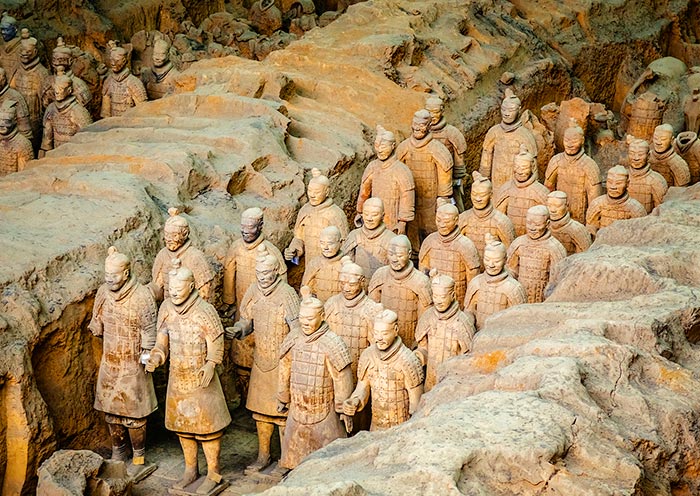
Magnificent Terracotta Army
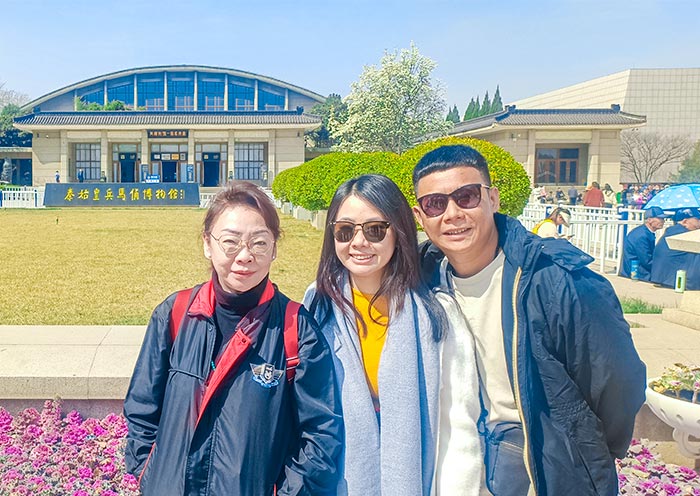
Magnificent Terracotta Army
Chinese Name: 兵马俑 (Bīng Mǎ Yǒng)
English Translation: Terracotta Army, Terracotta Warriors and Horses
Features: Thousands of life-size terracotta soldiers, horses, and chariots in battle array
Type: World Heritage Site, Historical Site, Museum, Cultural Landmark
History: Constructed in 246–206 BC, discovered in 1974
Construction Purpose: To accompany and protect the first emperor of China - Qin Shi Huang in the afterlife
Opening hours: Peak Season (March 16 to November 15): 08:30-17:00
Low Season (November 16 to March 5): 08:30-16:30
Location: Emperor Qin Shihuang's Terracotta Army Museum, 25 miles (40 km) northeast of Xian
Time needed: Half Day
Suited to: History and Chinese culture enthusiasts
Physical requirements: Indoor sightseeing, moderate walking, wheelchair accessibility available.
The discovery of the Terracotta Army is an intriguing tale of accidental unearthing that took place in 1974 in Xi'an, Shaanxi Province, China. The story begins with a local farmer named Yang Zhifa and his brothers, who were digging a well in a rural area called Lintong.
While digging, they stumbled upon fragments of terracotta figures. Initially, they believed it to be an ancient kiln site, as pottery shards were not an uncommon find in the region. However, as they continued to excavate, they realized they had come across something extraordinary.
The local authorities were informed of the discovery, and archaeologists were called in to investigate the site. They soon uncovered a vast underground complex, containing thousands of life-sized terracotta soldiers, horses, chariots, and other artifacts.
The sheer scale and intricate craftsmanship of the terracotta warriors astonished the world. The archaeological site, now known as Emperor Qin Shi Huang's Mausoleum Site Museum, attracts millions of visitors each year.
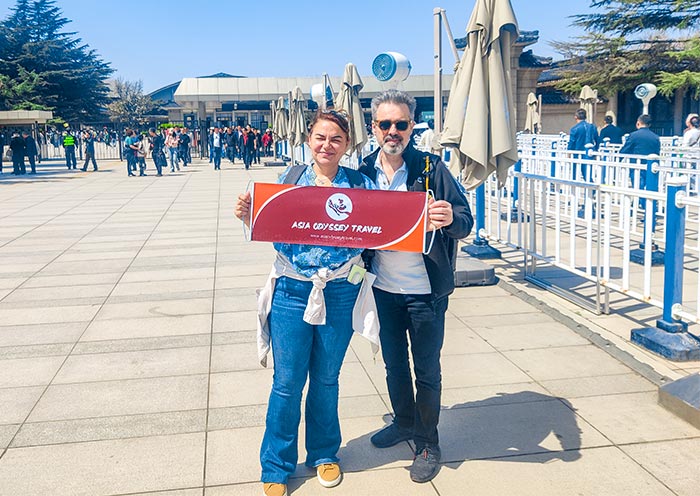
Excavating Terracotta Army in 1970s
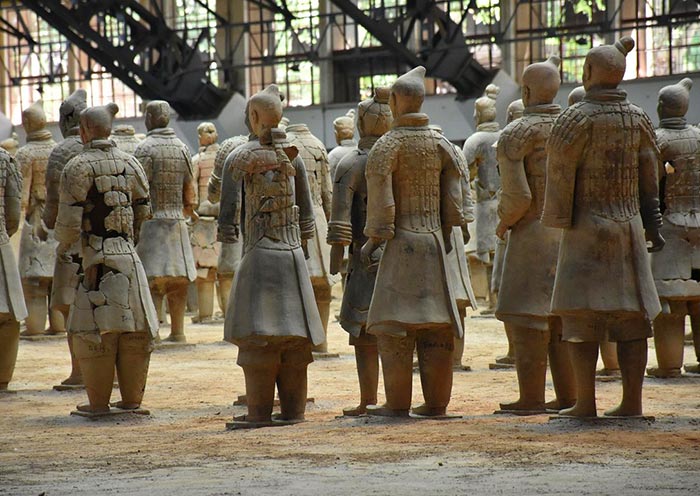
Terracotta Army
For more ideas, check out our Top Terracotta Army Facts>>
The story behind the Terracotta Army is a fascinating one that dates back over 2,000 years to ancient China. It revolves around the first emperor of China, Qin Shi Huang, who wanted to protect and preserve his power and rule even in the afterlife.
Qin Shi Huang ascended to the throne at the age of 13 and unified the warring states of China, establishing the Qin Dynasty. As a powerful ruler, he had a grand vision of creating an elaborate burial complex that would accompany him into the afterlife. This complex included the famous Terracotta Army.
The Terracotta Army was built to guard Qin Shi Huang's tomb, which was constructed to replicate his empire. It is estimated that around 8,000 life-sized terracotta soldiers, along with chariots, horses, and other figures, were meticulously crafted by skilled artisans. Each warrior had unique facial features, hairstyles, and armor, reflecting the diversity of the Qin Dynasty's military forces.
The warriors were positioned in massive underground pits, arranged in battle formation to protect the emperor's tomb from potential threats. These clay soldiers were believed to come to life in the afterlife and serve the emperor just as they did during his reign.
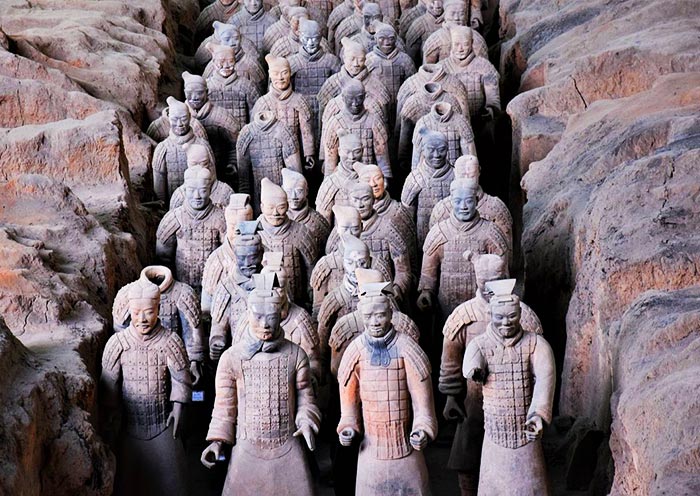
Terracotta Army

Terracotta Army
Qin Shi Huang, originally named Ying Zheng, was the first emperor of a unified China. He ascended to the throne of the Qin state at the young age of 13 in 246 BC. Through political alliances, innovative strategies, and military conquests, he consolidated the warring states into one united empire by 221 BC and took the title of the First Emperor.
His reign marked significant progress in administrative efficiency and cultural unity. He standardized units of measurement, currency, and the writing system to facilitate communication and commerce across the empire.
One of the most famous aspects of Qin Shi Huang's life is his elaborate burial site, known as the Mausoleum of the First Qin Emperor, located in Lintong, Shaanxi Province. This site is most famous for the Terracotta Army, a vast collection of life-size terracotta soldiers, horses, and chariots, intended to protect the emperor in the afterlife. He also initiated the construction of the Great Wall to protect the nation from northern invaders.
Despite his significant achievements, Qin Shi Huang's rule was also marked by tyranny and oppression. He carried out large-scale book burnings and buried scholars alive to suppress intellectual discourse. His death in 210 BC led to a quick end to the Qin dynasty, as rebellions broke out and the country fell into chaos until the rise of the Han dynasty.
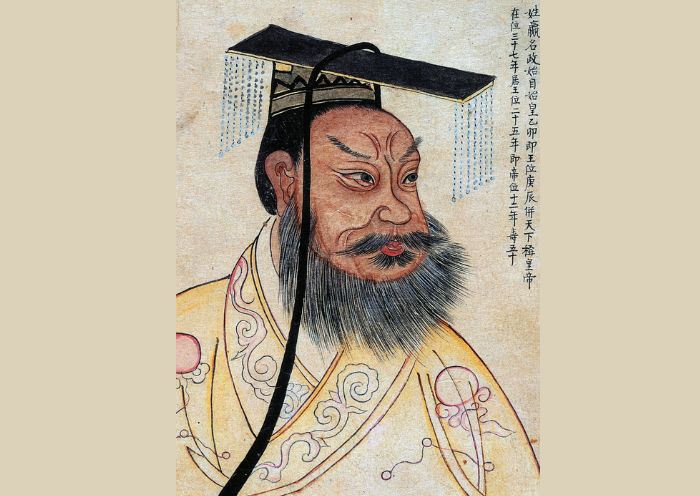
Qin Shi Huang
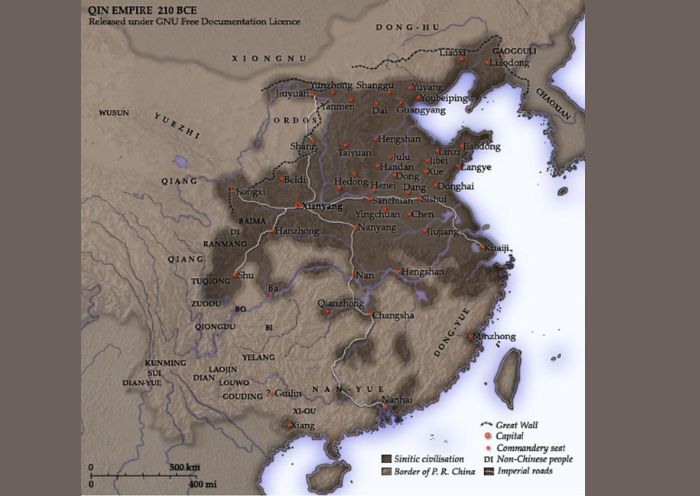
Territories of the Qin Empire
For more ideas, check out our Who Made Terracotta Army>>
Scale and Lifelike Detail: The sheer scale of the Terracotta Army is breathtaking. The soldiers, numbering in the thousands, were created life-sized and intricately detailed. Each warrior has distinct facial features, hairstyles, and attire, representing the diversity within Qin Shi Huang's real-life army.
Representation of the Army: The warriors were arranged according to the military hierarchy of the time, providing a detailed overview of the military structure during the Qin Dynasty. The statues include not just soldiers, but also horses, chariots, and officers, forming a complete picture of the military organization.
Craftsmanship and Technique: The level of craftsmanship and the techniques employed in creating the Terracotta Warriors is remarkable. The warriors were crafted using terracotta clay and baked in a kiln. The use of interchangeable molds for various body parts, followed by detailed hand finishing, allowed for mass production without sacrificing individuality.
Historical Significance: The Terracotta Army offers valuable insight into the military, cultural, and technological aspects of the Qin Dynasty. The statues reveal details about military hierarchy, weaponry, and armor used during that period. Furthermore, the discovery provides a unique snapshot of the artistic and technological advancements of ancient China.
Archaeological Importance: The Terracotta Warriors site is of immense archaeological importance. Beyond the pits housing the warriors, the site features other structures and a variety of artifacts that shed light on the life and reign of Emperor Qin Shi Huang.
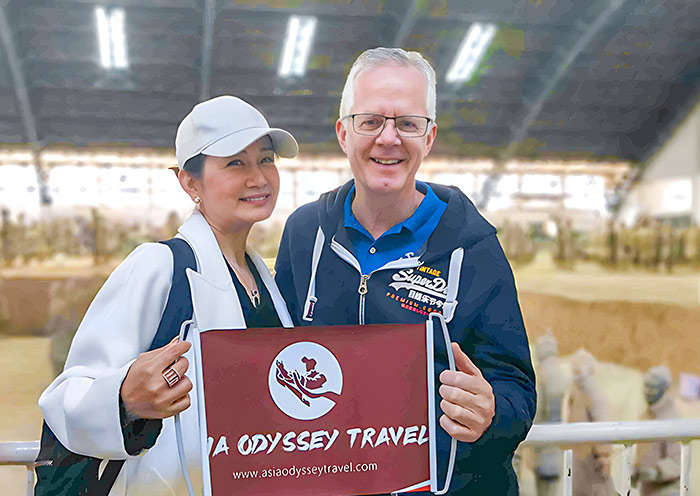
Terracotta Army
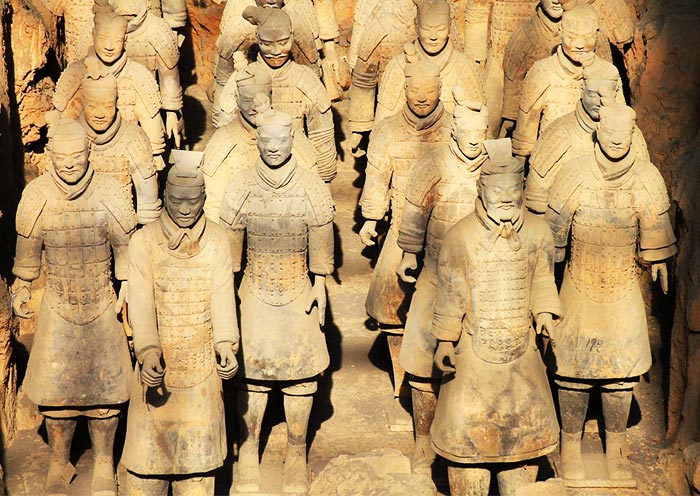
Terracotta Army
For more ideas, check out our Terracotta Army Types>>
The Terracotta Warriors, also known as the Terracotta Army, are made primarily of terracotta clay. The statues were created by skilled artisans during the reign of Emperor Qin Shi Huang. The process involved molding the clay into different parts of the body, such as the head, torso, arms, and legs, which were then assembled and further refined. Once the sculptures were complete, they were fired in kilns to harden the clay and make it durable. The statues were also painted with vibrant colors, although much of the paint has faded over time.
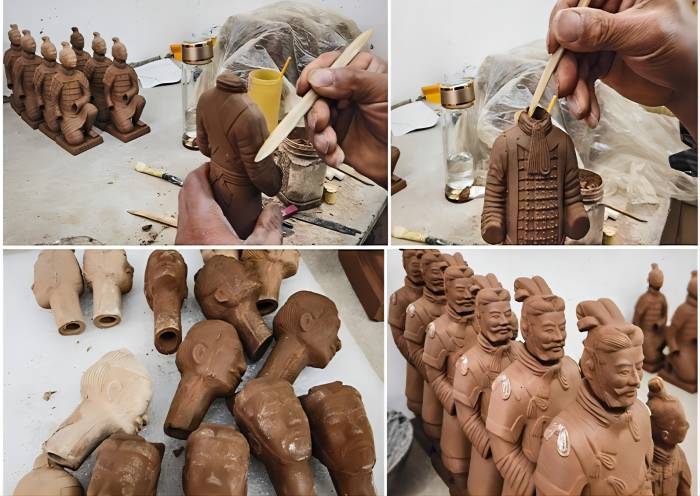
Make a Miniature Terracotta Warrior
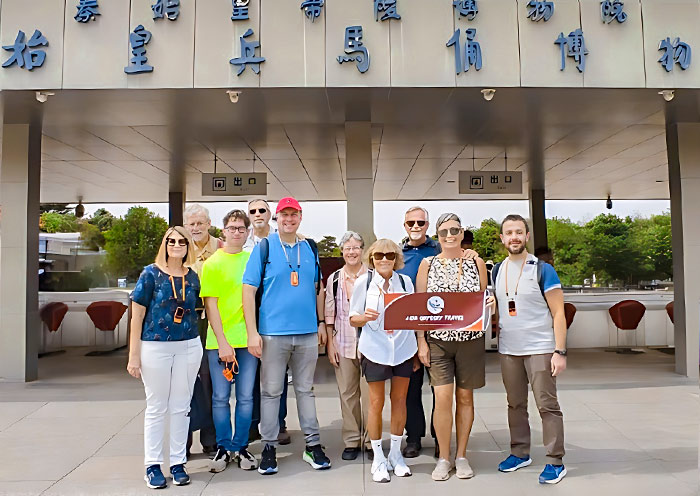
Terracotta Warriors
For more ideas, check out our How to Make Terracotta Army>>
The Army of Terracotta Warriors Site is located in Lintong District, Xian, in the Shaanxi Province of China. They were found buried on the eastern side of the Mausoleum of Emperor Qin Shi Huang. This site is approximately 40 kilometers northeast of the city center of Xian, formerly known as Chang'an, is one of the oldest cities in China and the oldest of the Four Great Ancient Capitals, having held the position under several of the most important dynasties in Chinese history.
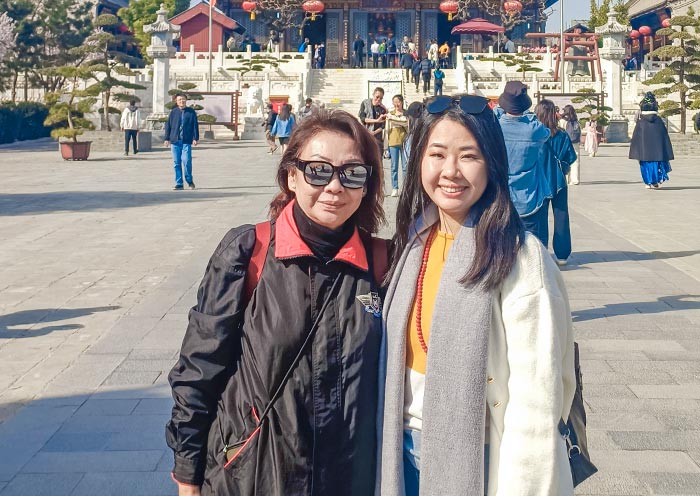
Emperor Qin Shihuang's Terracotta Army Museum
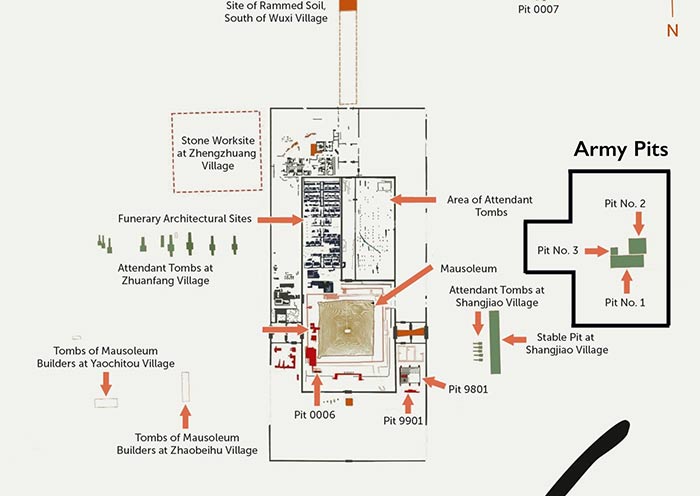
Map of Emperor Qin Shihuang's Terracotta Army Museum
The Emperor Qin Shihuang's Terracotta Army Museum, which houses the main pits containing the warriors, is divided into three sections: Pit 1, Pit 2, and Pit 3, each with its own significance and exhibits.
There are three main pits that house the majority of the Terracotta Warriors:
Pit 1: The Showcase of Warriors
This is the largest of the three pits, with a size equivalent to that of an airplane hangar. It measures 230 meters in length and 62 meters in width, while its depth varies between 4.5 to 6.5 meters from the current ground level. The pit covers an area of approximately 14,260 square meters.
It is estimated to contain over 6,000 terracotta figures, but fewer than 2,000 are currently on display. All soldiers and horses within this pit face east, arranged in a rectangular formation. Each figure is armed, showcasing the weaponry of the time, including long spears, daggers, and halberds. The vanguard is comprised of three rows of infantry standing at the easternmost end of the formation, while closely behind is the main force, 38 columns of infantrymen and chariots. On the left and right sides and at the western end, there is a row of warrior figures each facing north, south, and west, respectively, serving as the flank guard of the formation. The impressive arrangement of these warriors and horses provides a realistic glimpse into the formidable Qin military force.
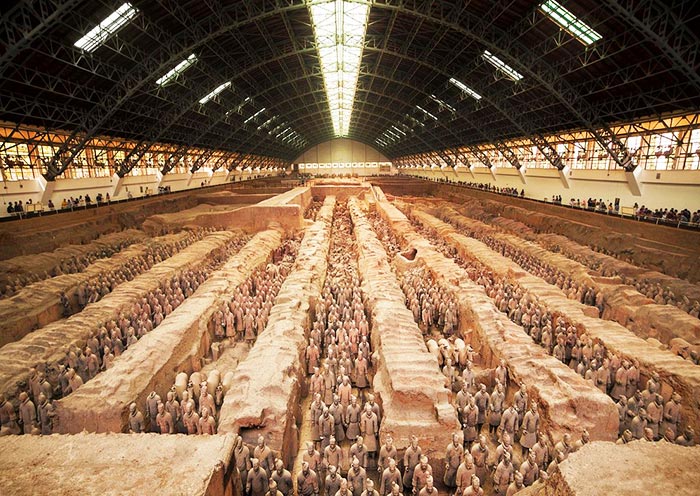
View from Pit 1
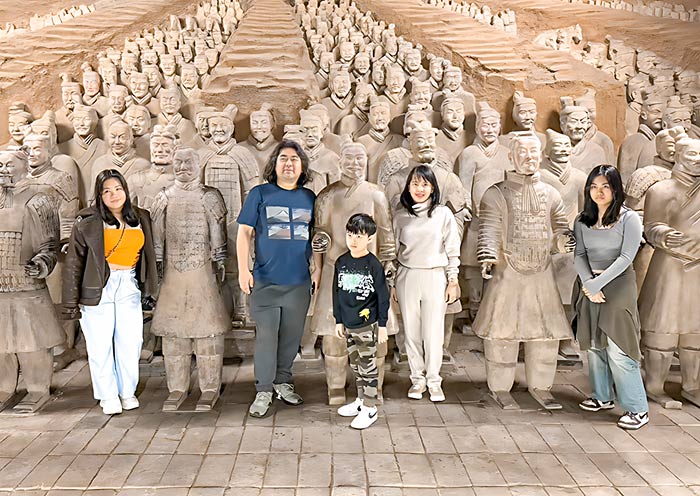
View from Pit 1
Pit 2: The Unveiling of the Ancient Army:
Located about 20 meters to the north of Pit 1, Pit 2 exhibits a distinct L-shape or "curved ruler" shape, providing a unique and strategic military formation. Spanning 124 meters in length and 98 meters in width, the pit covers an area of approximately 6,000 square meters. The pit sits about 5 meters below the current ground level.
It consists of four units. The first unit houses rows of kneeling and standing archers, ready for battle. The second unit features a chariot war array, offering a rare glimpse into the chariot warfare tactics of the Qin Dynasty. The third unit presents a mixed force of infantry, chariot riders, and troopers standing in a rectangular formation, suggesting the versatility of the Qin army. The final unit includes numerous troopers armed with weapons. Excavation and restoration work is still ongoing in this pit.
This pit is notable for its complex layout and variety of military figures, including standing and kneeling archers, cavalry, charioteers, and infantry. The strategic arrangement of the soldiers in Pit 2 showcases the advanced military tactics employed by the Qin Dynasty. Despite its smaller size compared to Pit 1, Pit 2 offers a richer diversity of the army, revealing even more about the ancient military strategy and mysteries of the ancient army array.
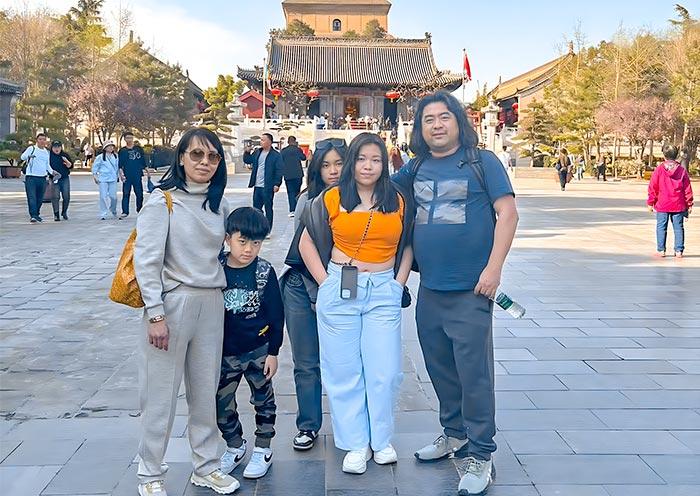
View from Pit 2
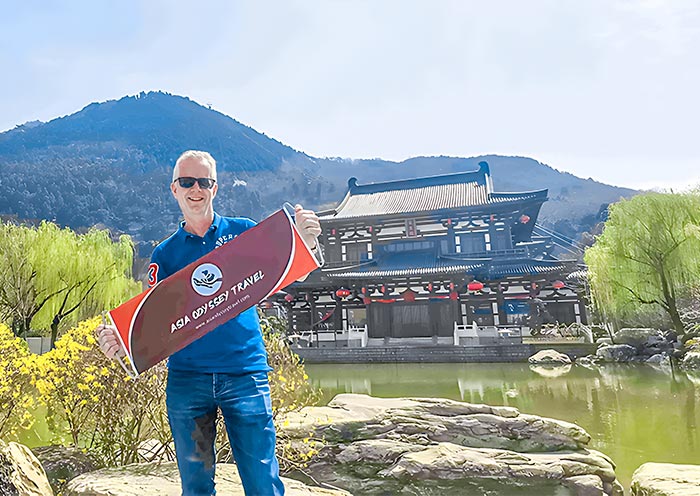
View from Pit 2
Pit 3: The Command Center
With a layout that resembles an concave shape, the pit 3 measures 28.8 meters in length and 24.57 meters in width. It sits approximately 5.2 to 5.4 meters below the current ground level, covering an area of 520 square meters. It is estimated to contain over 72 terracotta figures and horses.
Believed to be the command center, Pit 3 is the smallest but contains the highest-ranking figures. Here, you'll find officials, generals, and a beautifully decorated chariot, providing an insight into the command structure and hierarchy within the Qin Dynasty's military.
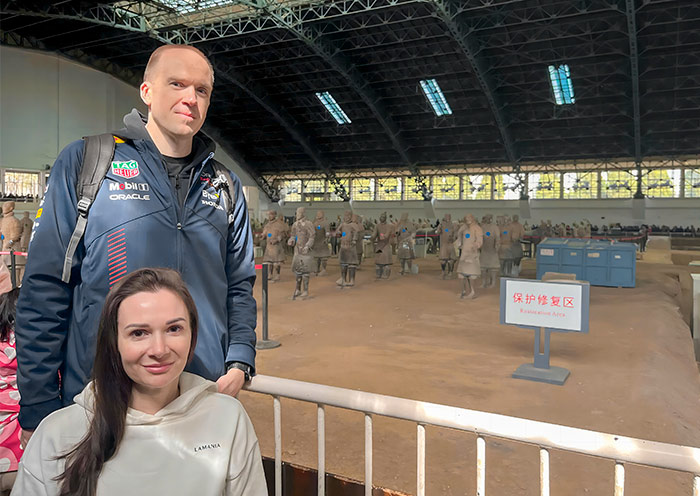
View from Pit 3
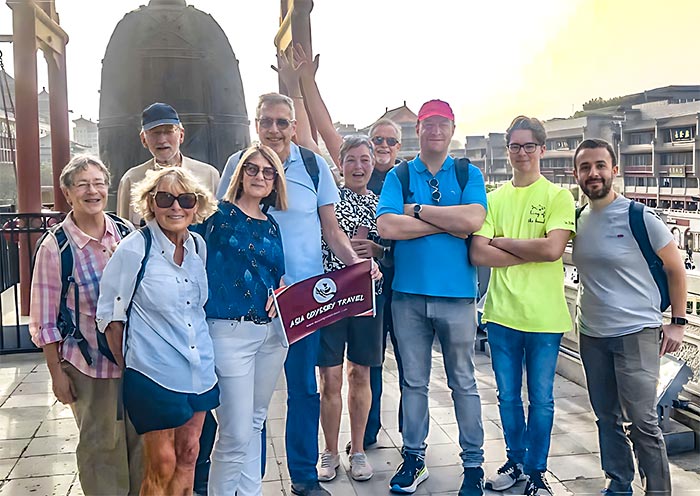
View from Pit 3
Aside from the pits, there several other exhibition halls that showcase a range of artifacts. These include remnants of the palatial structures, ancient utensils, pottery, and other artifacts that provide a broader perspective of the rich history and culture of the Qin Dynasty.
For more ideas, check out our How to Visit Terracotta Army>>
Aside from the pits, there several other exhibition halls that showcase a range of artifacts. These include remnants of the palatial structures, ancient utensils, pottery, and other artifacts that provide a broader perspective of the rich history and culture of the Qin Dynasty.
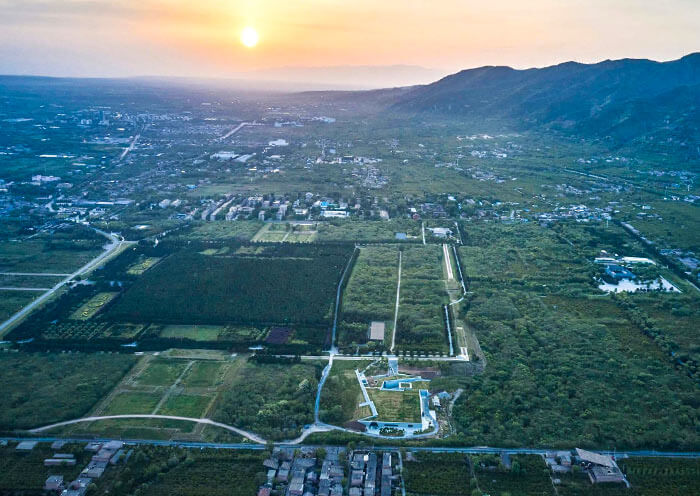
Mausoleum of Emperor Qin Shi Huang
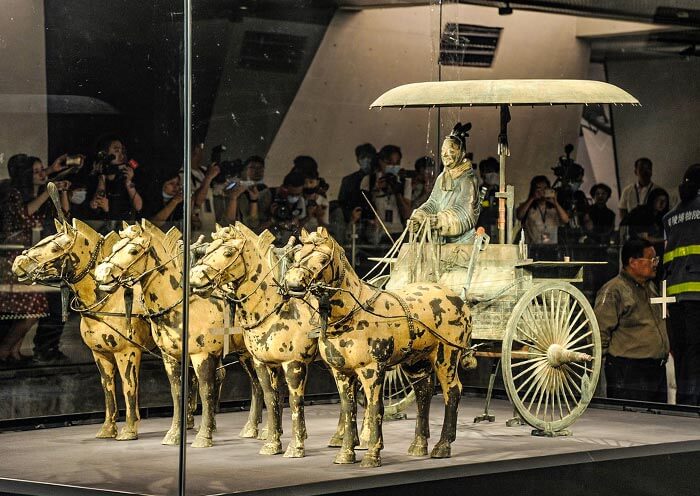
Bronze Chariots Museum
To visit the Terracotta Army, it's essential to book your tickets in advance due to the museum's maximum daily capacity of 65,000 people. Once this limit is reached, ticket sales will be stopped for the day.
The Emperor Qinshihuang's Mausoleum Site Museum has implemented a real-name reservation system. This means that all visitors (including those who are entitled to policy-free tickets and visitors from Hong Kong, Macao, Taiwan, and foreign countries) must book their tickets under their real names. Booking can be done through the official website or the WeChat public account of the museum.
It's recommended to book your tickets well in advance, especially during peak tourist seasons, to ensure you won't miss this incredible historical site. Alternatively, you might consider attending a guided tour for a more enriching and hassle-free experience. Tours typically include the reservation process in their service, allowing you to focus on the incredible history and legacy of the Terracotta Warriors.
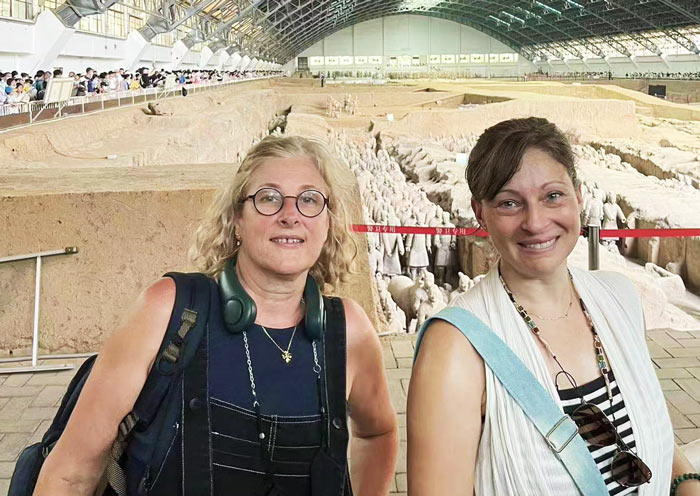
Our Guests in Terracotta Army
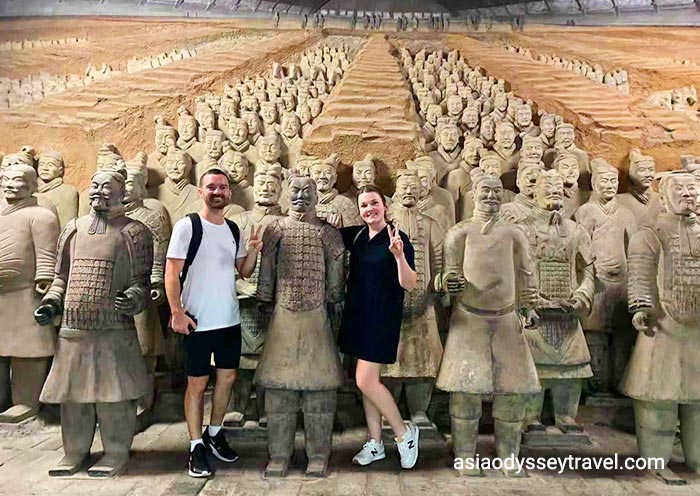
Our Guests in Terracotta Army
For a complete, immersive experience of the Terracotta Warriors, touring with a reputable travel agency like Asia Odyssey Travel can be an excellent choice. Asia Odyssey Travel offers guided tours that not only take care of the reservation process but also provide you with knowledgeable guides to enlighten you about the historical and cultural significance of this unique archaeological site.
We offer a variety of carefully designed Xian tours, including Classic Xian Tours, Terracotta Warriors Tours, Day Tours, and Mount Huashan Tours, tailored to meet your needs and desires. Whether you prefer a private tour with a flexible itinerary or a small group tour without compromising on quality, Asia Odyssey Travel has the perfect tour for you, ensuring that your journey to Xian is a worry-free vacation.
If you're looking to extend your stay in Xian into a longer vacation, Asia Odyssey Travel also offers a range of inspiring ideas through our China tours from Xian. Our professional travel consultants are ready to assist you in customizing a tailor-made Xian Tour at the best local price.
Book your tour today and prepare to be awed by the grandeur and splendor of the Terracotta Warriors.